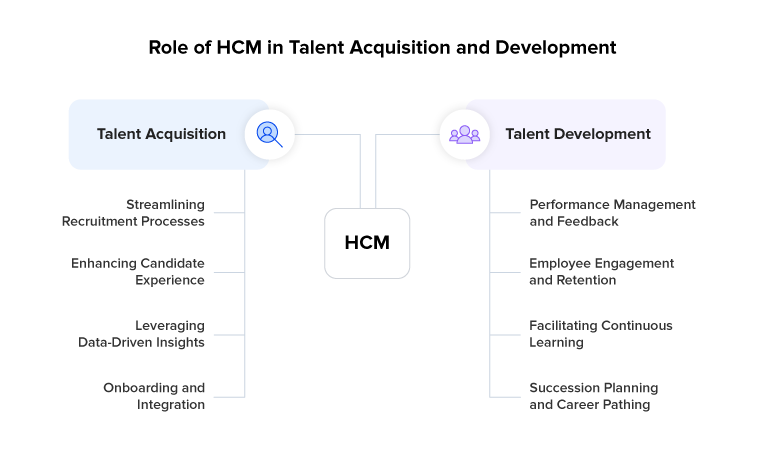How HCM Transforms Talent Acquisition & Development in 2025

Table of Contents
In this competitive market, attracting talent is difficult, but retaining them through constant innovation is even more challenging for organizations. Almost every company feels that retaining employees is more difficult than hiring them. This shows why most organizations face challenges in talent acquisition and development. This aspect also includes certain internal factors, such as a poor candidate experience, and external factors like market trends. Employees are not just seeking good pay but are also focusing more on the company culture and values.
Organizations constantly face issues related to talent acquisition and retention. Human Capital Management (HCM) includes a set of practices and tools used to develop an organization’s workforce. The system assists with task management, including recruitment and performance evaluations. Additionally, it covers aspects like talent development and benefits administration. The HCM platform boosts organizational productivity and helps achieve goals by motivating the workforce.

What is the Importance of Talent Acquisition and Development
HCM in talent acquisition and development directly impacts business performance and reduces costs due to low employee turnover. Below mentioned are some reasons why HCM in talent acquisition and development is important.
Alignment with Business Goals
Before the acquisition process, an organization uses a proactive approach to identify current operational needs and future role requirements. This approach helps reduce skill gaps and build a strong talent pipeline.
Cost Efficiency
When the talent acquisition process is structured, it helps reduce hiring costs. Also, when organizations focus on the specific skills they need in each role, it improves the quality of each hire. As skilled employees are hired, the need for additional training and its costs are reduced.
Enhanced Innovation
Organizations can bring innovation by adapting new technologies and strategies in the recruitment process. This can result in fresh and creative talent acquisition and employee development approaches. Also, when skilled employees are hired, they introduce new ideas, which results in increased productivity.
Enhanced Performance
Skilled employees contribute to their work efficiently and can see their careers grow professionally. This leads to enhanced productivity and profitability.
Strong Employer Brand
A strong talent strategy improves market reputation and attracts top candidates.
Succession Planning
An HCM platform helps organizations identify some of the high-potential employees for leadership positions.

What is the Role of HCM in Talent Acquisition?
HCM can help organizations identify and recruit the right employees in their hiring processes. It provides various tools and functionalities to recruit and retain employees. Below mentioned are the roles of HCM in talent acquisition.
Streamlining Recruitment Processes
Due to various recruitment challenges, organizations use an HCM system to manage their hiring processes. The platform helps integrate with recruitment tools, like Applicant Tracking System (ATS). The system can simplify hiring tasks, like matching the skills of a candidate with the requirements of the job. The platform is centralized so that HR professionals can fetch the data anytime they want, which leads to data consistency.
Enhancing Candidate Experience
An HCM platform can help organizations enhance and manage their entire recruitment process. The system combines the recruiter and the candidate, increasing the process’s efficiency. ATS helps in application submission and keeps the candidate informed about the procedure. HCM platforms are transparent in the hiring process as the data is centralized for quick decision-making related to the recruitment process.
Leveraging Data-Driven Insights
HCM systems make use of data analytics to help HR professionals improve their decision-making. They can identify talent gaps and help develop strategies based on insights for talent acquisition. These strategies help make unbiased decisions regarding talent acquisition and retention. Data analytics can also help identify some of the most effective channels for sourcing candidates. HR professionals use analytics to make informed decisions related to the hiring process.
Onboarding and Integration
The onboarding process includes introducing the new employee to the organization. The system provides the necessary information and resources for employees to understand their jobs. HCM can send automatic welcome emails and provide access to important information documents. It gives ongoing support to new employees by providing training to increase their engagement. This assists employees in acclimating to the company culture and their new job responsibilities.

What is the Role of HCM in Talent Development?
An HCM platform provides organizations with various tools to attract and retain employees. Some of the frameworks are developed to coordinate individual goals with company goals. This is practiced to keep the workforce motivated. Below mentioned are the roles of HCM for talent development.
Performance Management and Feedback
Organizations support employee growth to achieve business goals and increase productivity. Performance management helps set goals and provide feedback to employees. During this process, managers can know the skills and capabilities of their employees and help them improve to achieve goals. When employees are provided with continuous feedback, they can work more on their weaknesses.
Employee Engagement and Retention
An HCM platform can create a positive work culture by improving communication and overall experience. When employees are given continuous training and development, it helps support their professional growth. Employees can feel motivated and engaged in their work when they develop new skills. HCM systems provide insights through analytics tools to understand areas of employee disengagement. This helps HR professionals make informed decisions.
Facilitating Continuous Learning
Employees can get personalized training recommendations to help them grow professionally. Organizations can promote a learning culture and help achieve business objectives. Training programs also provide insights into employees’ current skills and how to acquire new skills. Thus, employee skill development programs are created to obtain new skills.
Succession Planning and Career Pathing
Succession planning is a process where organizations develop and prepare internal employees to take key roles in the future. This planning in HCM helps find some necessary replacements within the organization. Employees can prepare for leadership roles and help businesses stay stable in times of recession. Also, career pathing through HCM can help employees by providing clear pathways for their career advancement. This will help employees to get some clarity on the skills needed to move up in the hierarchy.

Get Started with the Best HCM Software
The role of HCM in talent acquisition and development is important. This technology helps create strategies and new work opportunities. Workplace culture is also changing to more flexible work and raising employee expectations, which is why the use of an HCM platform has increased. As some of the HR processes are managed efficiently, HR professionals can spend more time focusing on other vital tasks.
factoHR cloud-based HR platform helps organizations manage their employees’ entire lifecycle. HR professionals can simplify their HR processes, starting from hiring to offboarding. Schedule a demo to know more!
What does HCM Mean in Recruitment?
An HCM platform uses advanced technology to acquire and oversee employees, as they represent a crucial asset for any organization. Some of the activities included here are talent acquisition and onboarding new employees. These systems are implemented to provide growth and development to employees.
What is the Difference between ATS and HCM?
ATS focuses only on managing the recruitment and hiring process, which starts with job postings and ends with onboarding new employees. HCM is a broad concept that manages the entire employee lifecycle.
What is the Role of HR in Talent Development?
HR professionals look after the implemented strategies to attract and develop top talent. They develop talent management plans and provide employees with ongoing training support. This will make sure employees have enough skills and opportunities for career growth.
Grow your business with factoHR today
Focus on the significant decision-making tasks, transfer all your common repetitive HR tasks to factoHR and see the things falling into their place.

© 2025 Copyright factoHR


